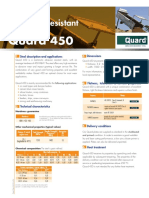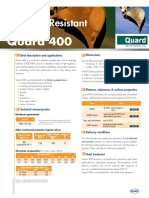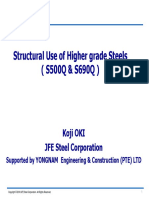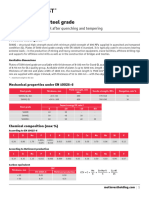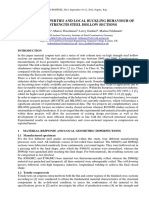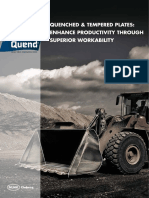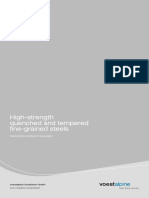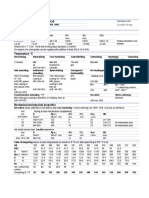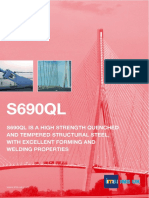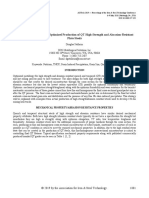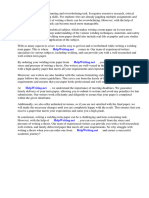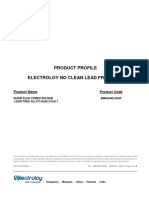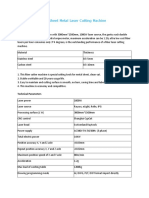abrasion resistant SteelS
QuARD 500
1. Steel description and applications 3. Dimensions
Quard 500 is a martensitic abrasion resistant steels, with an Quard 500 at present is supplied in the following range:
average hardness of 500 HBW. Its very high resistance to abrasive • thickness: 4 - 64 mm
wear and impact makes it ideal where long service life is required. • width: 1500 - 3100 mm
With the combination of superior hardness and strength, Quard For more information, please check our website or contact
500 is an optimal choice for the recycling and mining industry. your local NLMK Clabecq representative.
Quard 500 is mainly recommended for the following applications:
• screeners 4. Flatness, tolerances & surface properties
• crushing and pulverizing equipment Quard 500 is delivered with a unique combination of excellent
• conveyors belts flatness, tight thickness tolerances and superior surface finish.
• grapples
• scrap presses Feature Norm
- EN 10029: . Class N (standard) &
2. Technical characteristics FLATNESS . Class S PLUS
THICKNESS tolerance -- meets
Hardness guarantee and exceeds EN 10029 Class A
tighter tolerances upon request PLUS
Brinell hardness test, HBW
Hardness according to EN ISO 6506-1,
Shape, length, width meets EN 10029
is performed 1 - 2 mm below the plate tolerances
HBW = 470 - 530 surface once per heat and 40 tonnes.
exceeds the usual market standards,
SURFACE properties PLUS
EN 10163-2 Class B3
Other mechanical properties (typical values)
Charpy-V Yield Strength Tensile Strength Elongation 5. Delivery conditions
(MPa) - Transverse - A5
notch impact test (MPa) (%) Our Quard plates are supplied as standard in the shotblasted and
primed condition. In order to maintain a good weldability and
30 J 1500 1700 8 laser cutting performance, a low zinc silicate primer is applied.
(longitudinal at -40°C)
Plates can also be delivered unpainted.
Chemical composition The steel is grain refined. 6. Heat treatment
Quard 500 receives its properties by quenching and when appli-
Max ladle analysis , %
cable by subsequent tempering. The properties of the delivery
Thickness C Si Mn P S Cr Ni Mo B
4 - 20 mm 0,28 0,80 1,60 0,025 0,01 1,00 1,00 0,50 0,005 condition can not be retained after exposure at service or prehea-
20,01 - 40 mm 0,30 0,80 1,60 0,025 0,01 1,00 1,00 0,50 0,005 ting temperatures above 250 °C. Quard 500 is not intended for
40,01 - 64 mm 0,30 0,80 1,60 0,025 0,01 1,20 1,00 0,50 0,005 any further heat treatment.
Carbon equivalent, typical values, %
Plate thickness CEV(1) CET(2)
500 _V05 (10.2019)
4 - 20 mm 0,56 0,39
20,01 - 40 mm 0,60 0,42
40,01 - 64 mm 0,70 0,45
Plate/QT/Quard 1100
(1) CEV = C+Mn/6+ (Ni+Cu)/15+ (Cr+Mo+V)/5, (2) CET = C+(Mn+Mo)/10+Ni/40 +(Cr+Cu)/20
http://QT.nlmk.com
� 500 _V05 (10.2019)
7. Ultrasonic testing Due to the homogeneous properties and narrow thickness
Plate/QT/Quard 1100
tolerances of Quard 500, variations in springback is kept at
Ultrasonic testing (UT), is applied to secure the plate from dis- a low level. Grinding of flame cut or a sheared edge in the
continuities like inclusions, cracks and porosity. In thickness bending area is recommended to further prevent cracking
from 8 mm and up, all plates are UT tested and controlled during bending.
against class S2, E2, according to EN 10160.
Welding
Quard 500 has a very good weldability, granted by the optimal
8. General processing recommendations carbon equivalent of the steel. It can be welded using any of the
To obtain optimal work shop productivity when processing conventional welding methods, both as manual or automatic.
Quard 500, it is essential to use the recommended procedures Welding of Quard 500 is recommended to be performed
and tools given below. at ambient temperature not lower than +5°C. Subsequent
to welding, let the welded parts slowly cool down to room
Thermal cutting
temperature (never accelerate the cooling process of the weld).
Plasma and flame cutting can be performed without the need
for preheating in thicknesses up to 20 mm, provided the am- If welding using a heat input of 1.7 kJ/mm, preheating is not
bient temperature is above 0 °C. required in single plate thickness up to 12 mm. The interpass
Subsequent to cutting, let the cut parts slowly cool down to temperature used should not exceed 225 °C.
room temperature. A slow cooling rate will reduce the risk of Soft weld consumables, giving low hydrogen weld deposits
cut edge cracking (never accelerate the cooling of the parts). (<= 5 ml/100g), are recommended. The consumable strength
Cold forming should be as soft as the design and wear mode allows.
Quard 500 is very well suited for cold forming operations. In general, the welding recommendation of Quard 500 should
The minimum recommended R/t ratio when bending of Quard be in the accordance to EN-1011.
500 is given in the table below:
Machining
Quard 500 offers good machinability with HSS and HSS-Co
Thickness Transverse Longitu- Trans. Long.
(mm) to rolling dinal Width Width alloyed drills. The feed rate and cutting speed have to be
(R/t) to rolling (W/t) (W/t)
(R/t) adjusted to the high hardness of the material.
Face milling, counter boring and countersinking are best
t < 8.0 3.5 4.5 10 12
performed using tools with replaceable cemented carbide
8 ≤ t < 20 4.5 5 12 14
inserts.
t ≥ 20 6 7 16 18
R = Recommended punch radius (mm), t = Plate thickness (mm) , W – Die opening width (mm)
(bending angle ≤ 90°)
For more information regarding welding, cold forming and machining, please consult the respective manuals with technical recommendations on http://qt.nlmk.com
The elements in the data sheet are given for information only and reflect the information known at the time of publishing. This document is intended to give a general guideline for the purchasing and use
of the steels only. The transmitter of this document doesn’t accept any liability for any error or omission in the content of this document.
Values and components quoted must not be considered as being guaranteed unless specifically confirmed separately in writing.
NLMK Clabecq
http://QT.nlmk.com Rue de Clabecq 101 - B-1460 ITTRE - Belgium
Tel: +32 (0)2 391.91.00 - Fax: +32 (0)2 391.98.90
clabecq@eu.nlmk.com



